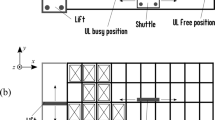Abstract
We consider an automated storage/retrieval system in which cargo moves between the storage/retrieval machines and the system entrance/exit stations through a single automated vehicle loop. Past studies indicated that the cargo waiting time in the loop is affected by the dispatching rules, which govern the sequence of the cargo to be handled. In this paper, we show that the loop configuration, which has received little research attention, also has a big impact on the cargo waiting time. When the first-come-first-served dispatching rule is used, we derive the relationship between the number of stations and the ratio of the average cargo retrieval time to the average cargo storage time. When the first-encountered-first-served dispatching rule is used, we show that even the arrangement of the input channel and the output channel of a station can have significant impact on the cargo waiting time. Furthermore, we derive a formula for the vehicle visit rate for each station under heavy traffic conditions. This formula helps to explain the phenomenon that the waiting times at different stations can be very different even when the loop is symmetrically designed and the cargo arrival rates to the stations are similar. In addition to analytical models, we use simulations to evaluate the performance of different loop configurations. Our research suggests that a substantial improvement can be achieved by making proper adjustments to the loop configuration.
Similar content being viewed by others
References
Bartholdi JJ III, Platzman LK (1985) Decentralized control of a fixed route automatic guided vehicle system. IIE Trans 21(1):76–81
Bozer YA, Kim J (1994) Determining transfer batch sizes in trip-based material handling systems. Proceedings of the 1994 international material handling research colloquium. Material handling industrial of America, Charlotte, NC, pp 51–91
Bozer YA, Srinivasan MM (1991) Tandem configurations for automated guided vehicle systems and the analysis of single vehicle loops. IIE Trans 23(1):72–82
Bozer YA, Srinivasan MM (1992) Tandem AGV systems: a partitioning algorithm and performance comparison with conventional AGV systems. Eur J Oper Res 63:173–191
Bozer YA, Cho M, Srinivasan MM (1994) Expected waiting time in single-device trip-based material handling systems. Eur J Oper Res 75:200–216
Gaskins RG, Tanchoco JMA (1987) Flow path design for automated guided vehicle systems. Int J Prod Res 25:667–676
Johnson ME, Brandeau ML (1993) An analytical model for design of a multi-vehicle automated guided vehicle system. Manage Sci 39:1477–1489
Johnson ME, Brandeau ML (1994) An analytical model for design and analysis of a single-vehicle asynchronous material handling system. Transp Sci 28:337–353
Malmborg CJ, Shen Y-C (1994) Heuristic dispatching models for multi-vehicle materials handling systems. Appl Math Model 18:124–133
Maxwell WL, Muckstadt JA (1982) Design of automatic guided vehicle systems. IIE Trans 14:114–124
Sinriech D, Tanchoco JMA (1994) SFT-Segemented flow topology. In: Tanchoco JMA (ed) Material flow systems in manufacturing, chapter 8. Chapman & Hall, London, pp 200–235
Smith JS (2003) Survey on the use of simulation for manufacturing system design and operation. J Manuf Syst 22(2):157–171
Srinivasan MM (1991) Nondeterministic polling systems. Manage Sci 37(6):667–681
Srinivasan MM, Bozer YA, Cho M (1994) Trip-based material handling systems: throughput capacity analysis. IIE Trans 26:70–89
Steenken D, Voss S, Stahlbock R (2004) Container terminal operation and operations research—a classification and literature review. OR Spectrum 26(1):3–49
Takagi H (1988) Queueing analysis of polling models. ACM Comput Surv 20(1):5–28
Thonemann UW, Brandeau ML (1997) Designing a zoned automated guided vehicle system with multiple vehicles and multiple load capacity. Oper Res 45:857–873
Venkataraman MA, Wilson KA (1991) A branch-and-bound algorithm for flow-path design of automated vehicle systems. Nav Res Logist Q 38:431–445
Wolff RW (1989) Stochastic modeling and the theory of queues. Prentice Hall, Englewood Cliffs, NJ
Author information
Authors and Affiliations
Corresponding author
Rights and permissions
About this article
Cite this article
Xu, D., Shi, N. & Cheung, R.K. Heavy traffic analysis of a single vehicle loop in an automated storage and retrieval system. OR Spectrum 29, 489–512 (2007). https://doi.org/10.1007/s00291-006-0060-5
Published:
Issue Date:
DOI: https://doi.org/10.1007/s00291-006-0060-5




